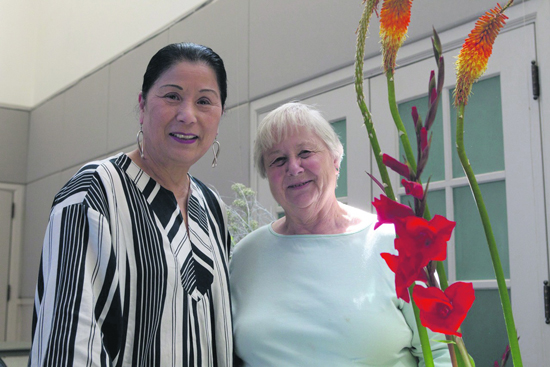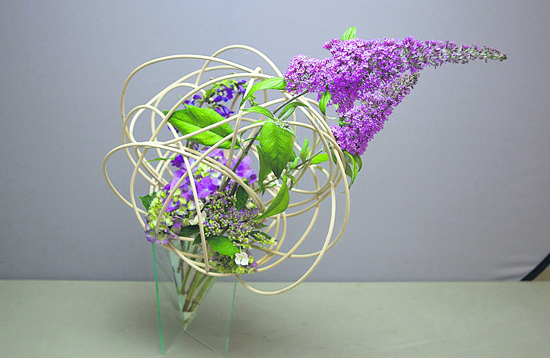| | Published July 6th, 2011
| Ikebana-The Art of Floral Sculpture
| | By Andrea A. Firth |  | | Soho Sakai with Elinor Cullen. Photos Doug Kohen |
It's 1:00 on Monday afternoon at the Orinda Community Center, and a large group of women and a few men cart bags and boxes filled with purple agapanthus, pink hydrangea, orange birds of paradise, indigo iris, carrot-colored day lilies, deep green lettuce leaves, and red and yellow peppers into the main auditorium.
 The buzz of conversation punctuated by laughter permeates the room as the thirty students get settled. The students quiet down, and the class looks forward for guidance from their teacher, Soho Sakai, an expert in the art of Sogetsu Ikebana, the disciplined art form of Japanese flower arrangement that combines nature, humanity, and creativity with lines, shape, form, and color.
The buzz of conversation punctuated by laughter permeates the room as the thirty students get settled. The students quiet down, and the class looks forward for guidance from their teacher, Soho Sakai, an expert in the art of Sogetsu Ikebana, the disciplined art form of Japanese flower arrangement that combines nature, humanity, and creativity with lines, shape, form, and color.
 Today's Ikebana class is inspired by the super nova, an energetic, fleeting, luminous, colorful stellar explosion.
Today's Ikebana class is inspired by the super nova, an energetic, fleeting, luminous, colorful stellar explosion.
 The theme for this 10-week session of Ikebana is natural forces, explains Lafayette resident Marilyn Kaplan, "Lava flows, water flows, avalanches, wind storms, we have done it all. And today we are doing super novas." After taking Sakai's Ikebana class for five years and mastering the four books to gain a diploma in the art, Kaplan has become a member of the "teacher's group." About twenty of Sakai's long-term followers have achieved this deep knowledge of the flower art form, and they collaborate and help to implement a new theme for each of the three sessions that run through the fall, winter, and spring.
The theme for this 10-week session of Ikebana is natural forces, explains Lafayette resident Marilyn Kaplan, "Lava flows, water flows, avalanches, wind storms, we have done it all. And today we are doing super novas." After taking Sakai's Ikebana class for five years and mastering the four books to gain a diploma in the art, Kaplan has become a member of the "teacher's group." About twenty of Sakai's long-term followers have achieved this deep knowledge of the flower art form, and they collaborate and help to implement a new theme for each of the three sessions that run through the fall, winter, and spring.
 Sakai has taught creative flower arrangement at the Community Center for twenty years. She is recognized as a world class expert in Ikebana, but for her students she is revered as an inspiration, a counselor, and a friend. "She's a superstar," whispers one student.
Sakai has taught creative flower arrangement at the Community Center for twenty years. She is recognized as a world class expert in Ikebana, but for her students she is revered as an inspiration, a counselor, and a friend. "She's a superstar," whispers one student.
 For Sakai, Ikebana is a way of living and thinking. It brings peace. "The mere act of looking at flowers makes it impossible to harbor violent thoughts," says Sakai. She strives to promote cross-cultural understanding through the beauty of flowers, and her class is representative of this effort. While some of the students are of Asian ancestry, the majority is not.
For Sakai, Ikebana is a way of living and thinking. It brings peace. "The mere act of looking at flowers makes it impossible to harbor violent thoughts," says Sakai. She strives to promote cross-cultural understanding through the beauty of flowers, and her class is representative of this effort. While some of the students are of Asian ancestry, the majority is not.
 "I have taken this class for 17 years, and that longevity is not unusual among Soho's students," says Orinda resident Mary Tischenko. Her arrangement consists of three pieces: a tall black vase with spiral arms, a multi-armed branch covered in neon orange spray paint, and a yellow and orange-tipped, spiked blossom. Placed just so, the simplicity of Tischenko's design effortlessly evokes the magnitude of a starry burst.
"I have taken this class for 17 years, and that longevity is not unusual among Soho's students," says Orinda resident Mary Tischenko. Her arrangement consists of three pieces: a tall black vase with spiral arms, a multi-armed branch covered in neon orange spray paint, and a yellow and orange-tipped, spiked blossom. Placed just so, the simplicity of Tischenko's design effortlessly evokes the magnitude of a starry burst.
 Sakai encourages her students to use interesting materials that they find in nature for their Ikebana creations. One woman had her husband stop the car along the highway so she could retrieve a tumbleweed from the side of the road. "I used a whole can of white spray paint on that," she exclaimed. She then interspersed white lilies and babies breath within the painted tumbleweed to create an arrangement emotive of a bright firework.
Sakai encourages her students to use interesting materials that they find in nature for their Ikebana creations. One woman had her husband stop the car along the highway so she could retrieve a tumbleweed from the side of the road. "I used a whole can of white spray paint on that," she exclaimed. She then interspersed white lilies and babies breath within the painted tumbleweed to create an arrangement emotive of a bright firework.
 Gordon Ward, one of the male minority in the class, is a formally trained potter. He started taking the class five or six years ago with his mother, Anne, who has been a Sakai follower for over 15 years. Both Wards are longtime Lafayette residents and enthusiasts of Japanese architecture and gardens. "I came to the class and quickly got hooked on Ikebana," says Gordon, who now creates ceramic vases and containers that are used by his classmates and Ikebana artists around the country.
Gordon Ward, one of the male minority in the class, is a formally trained potter. He started taking the class five or six years ago with his mother, Anne, who has been a Sakai follower for over 15 years. Both Wards are longtime Lafayette residents and enthusiasts of Japanese architecture and gardens. "I came to the class and quickly got hooked on Ikebana," says Gordon, who now creates ceramic vases and containers that are used by his classmates and Ikebana artists around the country.
 During the last hour of the three-hour lesson, the critique portion of the afternoon, the class moves around the room as a group to observe each student's arrangement, and Sakai provides insight into what works and what does not. "This is very touching. It makes me cry," says Sakai in response to a student's work. "Are you a good cook?" she asks another who has created an arrangement with lettuce leaves and vegetables. Sakai freely moves branches and is not shy about pulling out her clippers to trim flowers to create better proportion and visual lines for the arrangements. For Sakai, less is more. She achieves the right balance of flower, form, and space with a few quick adjustments, and her students are left guided and inspired.
During the last hour of the three-hour lesson, the critique portion of the afternoon, the class moves around the room as a group to observe each student's arrangement, and Sakai provides insight into what works and what does not. "This is very touching. It makes me cry," says Sakai in response to a student's work. "Are you a good cook?" she asks another who has created an arrangement with lettuce leaves and vegetables. Sakai freely moves branches and is not shy about pulling out her clippers to trim flowers to create better proportion and visual lines for the arrangements. For Sakai, less is more. She achieves the right balance of flower, form, and space with a few quick adjustments, and her students are left guided and inspired.
 "Such a mentor, we just love her," says a student as she breaks down her arrangement and packs up for the day, ready to do it all over again next week.
"Such a mentor, we just love her," says a student as she breaks down her arrangement and packs up for the day, ready to do it all over again next week.

|
 | | Mary Tischenko's super nova.
|  | |
|  | |
| | | | | | | Advertisement | | |
| | | print story
Before you print this article, please remember that it will remain in our archive for you to visit anytime.
download pdf
(use the pdf document for best printing results!) | | | Comments | | |
| | | | | | | | | | | | | | | | |





